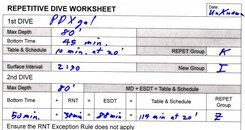Hi all,
Well I have a cautionary tale called How To Get Bent, otherwise known as The Stupidest Day of Diving Ever. This is a long post and if anyone reads it, I would be glad to hear anyone's opinions...
...The next day I get on the boat and we do a multilevel dive down to about 80 feet at max depth, gradually ascending throughout the dive to maybe 40 feet before surfacing. We were diving based on our dive master's computer and he said it would be "to NDL." I was sucking air out of nervousness and surfaced a good 15 minutes at least before everyone else did (they stayed down about an hour). The mooring line was at 40 feet and as I recall I surfaced along the line at probably a good pace, but who knows, maybe I went too fast? That's not even the best part.
I didn't do a safety stop. Why? I just forgot. How can I defend this? I can't. It was just stupidity.
I was scheduled to do three dives that day but after I got up, I felt OK except seasick. I decided to sit out the next dive and went to the hotel, where I immediately laid down on the hotel room bed and slept for an hour straight. Total surface interval was about 2.5, maybe 3 hours. Went back to the boat feeling great. Did the second dive, the same site, multilevel down to about max 70 or 75 feet this time and I was down a bit longer, maybe 50 minutes instead of 45? Again surfaced before everyone else for the same reason (fast air consumption). Again, dubious ascension and no safety stop. Again, indefensible. Afterward I felt great. We went back to the hotel and everything was fine...
pdxgal,
That is an interesting description you gave. I hope you don't mind, but I'm going to use it as a little review of the U.S. Navy Diving Tables (1971, which is what I have with me now). Your first dive was to 80 feet max for 45 minutes, which according to the Table 1-10 would go to the next higher time of 50 minutes. 80 feet for 50 minutes requires a stop at 10 feet for 10 minutes. For this exercise, we'll assume that your multi-level dive, because of the short time at 80 feet, actually put you still within the no-decompression limits, and effectively served as your decompression stop. But you would be in Repetitive Group "K". Your surface interval was 2.5 hours (conservatively). A surface interval of 2:30 would put you in Repetitive Group "F" according to Table 1-12. Now, if you are calculating your next dive, and it is 75 feet (80 feet on the table), your residual nitrogen time is 28 minutes. So before you began your dive, it was as if you had already been at 80 feet for 28 minutes. But you stayed down for 50 minutes. If you add your actual time of 50 minutes to the 38 minutes RNT you had already accumulated, you get a theoretical dive time of 50 + 38 = 88 minutes. According to Table 1-10, you should have then decompressed at 20 feet for 7 minutes, and 10 feet for 31 minutes for a total ascent time (including the actual ascent) of 34:20. Your new Repetitive Group would be "N" and you would need more than 12 hours of surface interval to go back to a "zero" condition.
This is how we used to compute our repetitive dives in the ol' days.
Now, because you were with an instructor with a computer, and doing a "multi-level" dive, you were not accumulating that much nitrogen in your tissues, because the assumption of the Navy Dive Tables is that you are at that depth the entire time. So you were okay.
The problem I have with your post is that there was no comprehension on your part as to how decompression actually works. Without a computer of your own, you really do not know what your actual decompression was. Without a dive watch, depth gauge and the tables to use to compute the dives like I did above, it is exceedingly difficult to know what your status is with regard to decompression. Flying after the dives could have compounded the problem if there had been a problem, but you would have had symptoms almost immediately.
One thing you may want to do is to go to the following link, and download the U.S. Navy Diving Manual for the I-Pad. (My wife has a new I-Pad, but I haven't dared to use it for this purpose yet--hence the use of my very old dive tables for this example.)
http://vintagescuba.proboards.com/index.cgi?board=general&action=display&thread=2893
In any case, you really should become more familiar with the dive tables and the diving computer. In my opinion, unless you do this you should restrict your diving to 33 feet or less while on vacation. That way, you know you won't have a problem. Don't depend upon others (the dive resort personnel, for instance), especially when diving at a remote location without ready access to a decompression chamber.
SeaRat
PS, I conducted a Google search for the current tables, and the tables have changed a bit since 1971. Here's the challenge to all here. First download the current U.S. Navy Diving Manual:
http://www.usu.edu/scuba/navy_manual6.pdf
Then do the same problem as above, using the new worksheets and tables in the current U.S. Navy Diving Manual. This is a good exercise for all divers, not just "vacation divers."
John C. Ratliff, CSP, CIH, MSPH
---------- Post added January 12th, 2013 at 02:36 PM ----------
Hint: the Repetitive Dive Worksheet is found on page 9-24, and the tables are found on pages 9-62 through 9-71 (to 80 feet of salt water).
SeaRat





